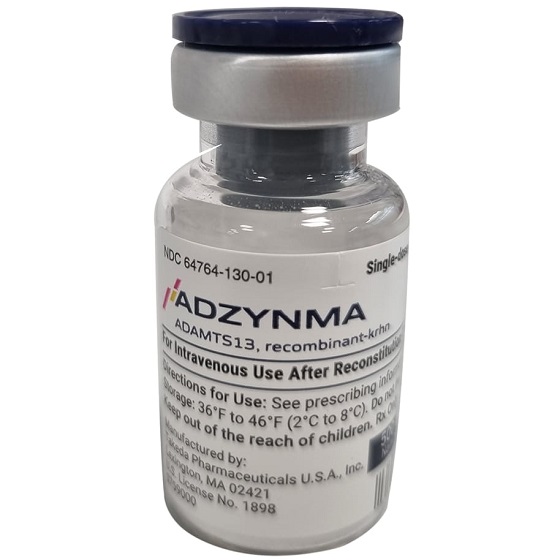What Are the Limitations of Using ADAMTS13?

What Are the Limitations of Using ADAMTS13?
In the realm of medical treatment, ADAMTS13 (Recombinant-krhn) has emerged as a significant drug for treating congenital thrombotic thrombocytopenic purpura (TTP), working through enzyme replacement therapy. The administration methods include prophylactic and on-demand treatments. For prophylactic use, it is injected once a week, with the dosage adjusted according to the patient's condition; for on-demand treatment during acute episodes, it needs to be injected continuously for several days until the symptoms subside. However, like many medications, its use comes with certain limitations. Let’s delve into what restrictions patients might encounter when using ADAMTS13.
1. Restrictions on Clinical Indications
ADAMTS13, an essential plasma protein involved in the blood coagulation process, plays a crucial role in preventing TTP. Its deficiency or dysfunction is closely linked to the development of TTP. While ADAMTS13 has demonstrated promising efficacy in treating acute TTP patients, its scope of application remains relatively narrow. At present, its effectiveness in treating chronic or recurrent TTP cases requires further investigation. Moreover, due to limited research on its impact on other thrombotic disorders, its clinical application in a broader range of conditions is restricted. This limitation means that only a specific group of patients can benefit directly from this treatment.
2. Production and Cost Challenges
The production of recombinant ADAMTS13 is a complex process that demands strict quality control and adherence to high production standards. These stringent requirements significantly contribute to its high manufacturing cost. As a result, the drug's accessibility is limited in certain regions. For patients with financial constraints, the high cost of ADAMTS13 treatment may be unaffordable, preventing them from receiving this potentially life - saving therapy. This economic barrier hinders the widespread adoption of ADAMTS13 in clinical practice, highlighting the need for more cost - effective production methods or financial assistance programs.
3. Concerns about Drug Safety
Similar to other recombinant protein drugs, the use of ADAMTS13 may trigger allergic reactions or other adverse effects. Although no severe adverse reactions have been reported in clinical trials thus far, individual patient responses can vary greatly. The uniqueness of each patient's body chemistry makes it difficult to predict how they will react to the drug. Additionally, the long - term safety of ADAMTS13 remains an area that requires more in - depth observation and research. This uncertainty regarding safety means that patients and healthcare providers must approach its use with caution.
4. Consideration of Comprehensive Treatment Plans
Using ADAMTS13 alone may not fully address the underlying issues of TTP. Its therapeutic effects are often optimized when combined with other treatments, such as plasma exchange and immunosuppressive agents. Therefore, when formulating a treatment plan, doctors need to take into account various factors specific to each patient, including their overall health status, the severity of the condition, and potential interactions with other medications. This comprehensive approach ensures that the treatment is both rational and effective, but it also adds complexity to the treatment process.
In conclusion, while recombinant ADAMTS13 offers great potential in the treatment of thrombotic thrombocytopenic purpura, several limitations exist in its clinical application. These limitations involve aspects such as indications, production costs, safety concerns, and the need for comprehensive treatment planning. Future research efforts should focus on overcoming these obstacles to enhance the use of ADAMTS13 and improve patient outcomes. If you have further questions or need more information about ADAMTS13, you can consult Dingxiang customer service for assistance.
Case Q&A
Case 1: Patient with Financial Constraints
Q: Mr. Smith, diagnosed with acute TTP, wants to use ADAMTS13 for treatment. However, he is worried about the high cost and cannot afford it on his own. What options does he have?
A: Mr. Smith can first consult his doctor to see if there are any local patient assistance programs or charity organizations that provide financial support for expensive medications like ADAMTS13. He can also discuss with his doctor alternative treatment options that may be more cost - effective or combinations of therapies that could potentially reduce the overall treatment cost. Additionally, reaching out to Dingxiang customer service might provide him with more information on accessible drug sources or potential cost - saving strategies.
Case 2: Patient with Uncertainty about Safety
Q: Ms. Johnson has been prescribed ADAMTS13 for her TTP treatment. She is concerned about the potential adverse reactions and the long - term safety of the drug. What should she do?
A: Ms. Johnson should have an in - depth discussion with her doctor. Her doctor can explain the possible risks based on her individual health condition and past medical history. The doctor may also monitor her closely during the initial stages of treatment, checking for any signs of adverse reactions. If she still has concerns, consulting Dingxiang customer service can offer additional resources and answers from a different perspective to help ease her worries.

